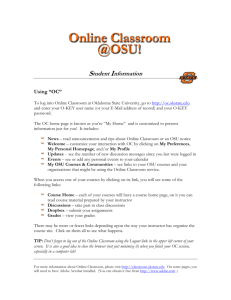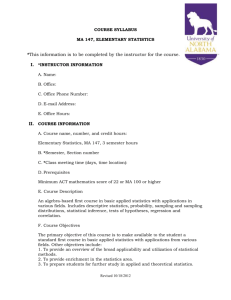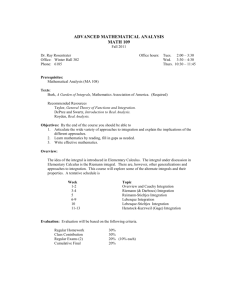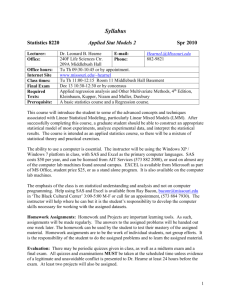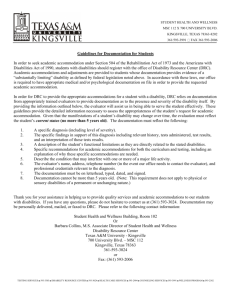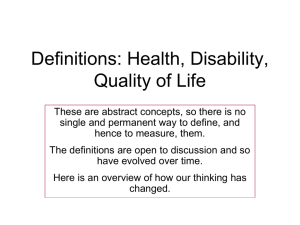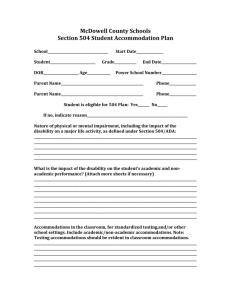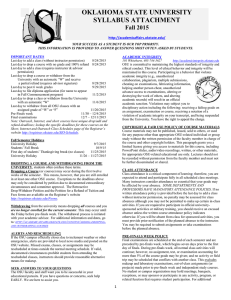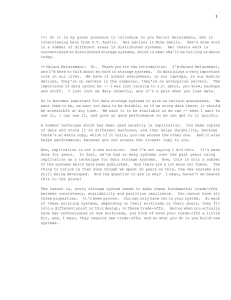HEALTH AND HUMAN PERFORMANCE
advertisement
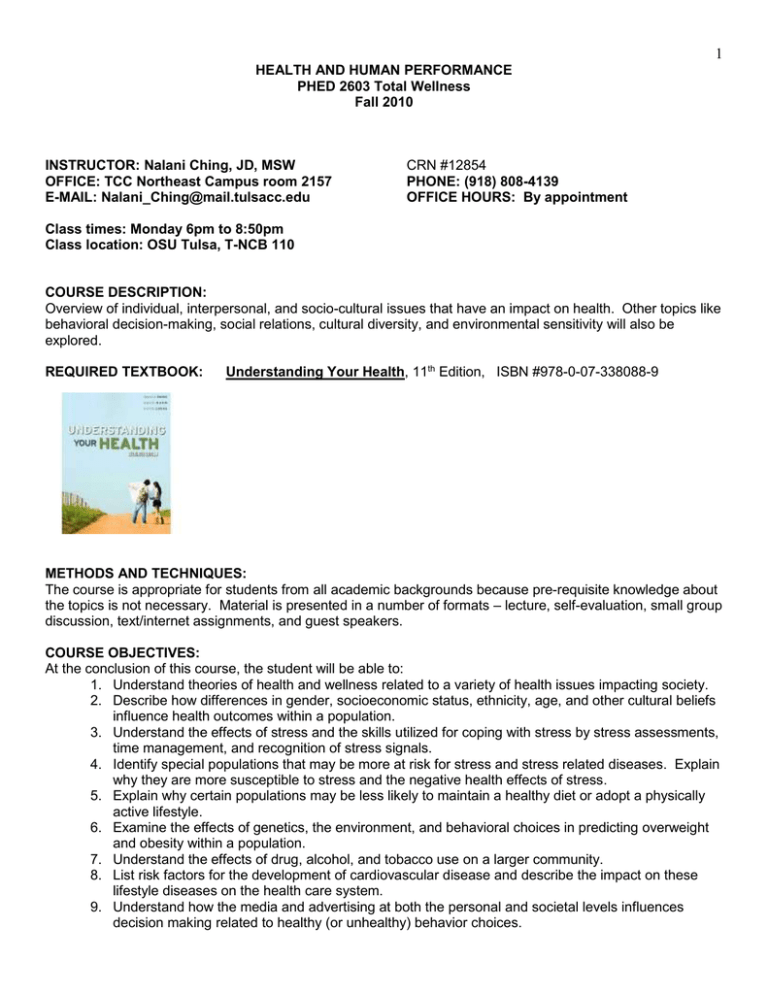
1 HEALTH AND HUMAN PERFORMANCE PHED 2603 Total Wellness Fall 2010 INSTRUCTOR: Nalani Ching, JD, MSW OFFICE: TCC Northeast Campus room 2157 E-MAIL: Nalani_Ching@mail.tulsacc.edu CRN #12854 PHONE: (918) 808-4139 OFFICE HOURS: By appointment Class times: Monday 6pm to 8:50pm Class location: OSU Tulsa, T-NCB 110 COURSE DESCRIPTION: Overview of individual, interpersonal, and socio-cultural issues that have an impact on health. Other topics like behavioral decision-making, social relations, cultural diversity, and environmental sensitivity will also be explored. REQUIRED TEXTBOOK: Understanding Your Health, 11th Edition, ISBN #978-0-07-338088-9 METHODS AND TECHNIQUES: The course is appropriate for students from all academic backgrounds because pre-requisite knowledge about the topics is not necessary. Material is presented in a number of formats – lecture, self-evaluation, small group discussion, text/internet assignments, and guest speakers. COURSE OBJECTIVES: At the conclusion of this course, the student will be able to: 1. Understand theories of health and wellness related to a variety of health issues impacting society. 2. Describe how differences in gender, socioeconomic status, ethnicity, age, and other cultural beliefs influence health outcomes within a population. 3. Understand the effects of stress and the skills utilized for coping with stress by stress assessments, time management, and recognition of stress signals. 4. Identify special populations that may be more at risk for stress and stress related diseases. Explain why they are more susceptible to stress and the negative health effects of stress. 5. Explain why certain populations may be less likely to maintain a healthy diet or adopt a physically active lifestyle. 6. Examine the effects of genetics, the environment, and behavioral choices in predicting overweight and obesity within a population. 7. Understand the effects of drug, alcohol, and tobacco use on a larger community. 8. List risk factors for the development of cardiovascular disease and describe the impact on these lifestyle diseases on the health care system. 9. Understand how the media and advertising at both the personal and societal levels influences decision making related to healthy (or unhealthy) behavior choices. 2 CLASS PROJECT: Behavior Change Project There will be four parts to the behavior change project. Each part should be typed in a legible 12 point font, double-spaced, with page margins no larger than 1.0”. Any references made should be in APA style (Publication Manual of the American Psychological Association, 5th edition). Projects are to be handed in during class on the day assigned. Failure to do so will result in a zero being assigned to that part. The primary objective of this project is for you to select and make a positive health behavior change. For example, this could include beginning an exercise program (let’s get fit!) to breaking a bad habit (those terrible cigarettes). Weight loss is not an appropriate goal as this is not a behavior. Project I: Health Risk Appraisal Due: Sept 13 Preparation for your Behavior Change Complete a personal health risk appraisal at the OSU Tulsa Wellness Center and submit a hard copy of the results as well as a page from the online assessment summary (see the bottom of the HRA from the Wellness Center for website to complete this). Your assessment at the OSU Tulsa Wellness Center must be scheduled with JJ Smith. Ms. Smith’s hours are Monday through Friday 8am to 5pm. Ms. Smith can be reached at (918) 594-8450, or at JJ.Smith@OkState.edu. Should you require a time that is not between 8am-5pm, you will need to schedule that well in advance with Ms. Smith. If you have questions regarding the assessment call the Wellness Center at (918) 594-8355. *If anyone is uncomfortable with the health risk appraisal please see your instructor. Project II: Health Behavior Change Contract Due: Sept 27 Fill out the behavior change contract with the objective of making a positive change in one modifiable health behavior over a period of eight weeks. Your instructor must approve your behavior change project before you begin. Weight loss is not an appropriate goal. Remember the behavior change should be positive and related to health. Due: Article 1 – Oct 11 Article 2 - Mar 12 Find two peer reviewed journal** articles pertaining to your chosen behavior modification project. Articles should be at least 3 pages in length. These articles must include empirical research addressing your chosen behavior. Summarize and critique each article in two typewritten double spaced pages. At least one of the articles should focus on how the individual behavior and the larger community interact. The summary should include a critical analysis of how an individual’s behavior may impact the greater community. For both summaries, you should include how you are going to use the information in the article to improve your behavior change and what steps or processes you have chosen to modify your behavior. Please be very explicit and detailed when adding this information. The purpose of the article summaries is to examine personal behavior and to stimulate reflection on how that behavior impacts others both at a community and societal level. Be sure to attach a copy of the referenced article to the summary. Citations must be in APA format. DO NOT PLAGIARIZE!! Project III: Health Behavior Change Articles **Examples of appropriate journals include, but are not limited to: Journal of American College Health, Medicine & Science in Sports and Exercise, Health Education and Behavior, Research Quarterly for Exercise and Sport, Journal of the American Medical Association, American Journal of Epidemiology, American Journal of Health Education, and Journal of Drug Education. Project IV: Behavior Change Project Summary Due: Apr 23 Write a report summarizing the outcome of your behavior change effort. This report should consist of a minimum of four pages, double-spaced, typewritten paper that summarizes your behavior change effort throughout the eight-week period. Please be sure to address the following in your summary: 1. What was your greatest success in this project? 2. What will be your biggest area of future improvement? 3. What obstacles did you have to overcome in achieving your goal? 3 4. What did you learn about yourself? 5. Was your behavior change effort a success? 6. If your behavior project was not successful, why? Looking back on the situation, what could you have done differently to make it a success? 7. What steps did you take in measuring your success? Attach any materials used in your measurements (nutrition log, notes, lists, daily calendar, records, or any other documentation) of how your personal success was measured. 8. How do you conceptualize your experience in light of the research articles you reviewed? 9. What does your personal experience lead you to believe about the theory of Health Behavior? GRADING: In this course, there will be four exams: three during the semester and the final. Exams will consist of multiple choice, T/F and/or occasional essay questions derived from class lecture, discussion activities, and text readings. No make-up exams will be given unless pre-approved. Sporadic pop-quizzes may be given throughout the semester. Exam 1 Exam 2 Exam 3 Final = 100 points = 100 points = 100 points = 100 points Additional Activities including pop quizzes, class activities, etc. = 100 points Project I Project II Project III Project IV = = = = A= B= C= D= F= 90%-100% 80%-89% 70%-79% 60%-69% Below 60% 25 points 15 points 60 points 50 points *Projects will be graded for content and writing quality. ATTENDANCE: In order for you to achieve the most out of this class, you must attend and attend on time. Attendance will be taken. Tardiness is not acceptable. Two tardies will be considered an absence. CLASS PARTICIPATION: Student involvement is an integral component of the learning process. Participation in class discussions and activities is strongly encouraged. Please turn off cell phones during class. Texting during class is also not appropriate. ACADEMIC REGULATIONS: Important information regarding admission-withdrawal, student status, graduation requirements, enrollment, grades/grading, academic dishonesty, and other topics are included in syllabus attachment provided by the University: http://osu.okstate.edu/acadaffr/aa/syllabusattachment-Fall.htm ACADEMIC DISHONESTY AND MISCONDUCT: Academic dishonesty and misconduct, as defined by Oklahoma State University, will not be tolerated. Procedures for dealing with any fraudulent academic behavior have been outlined by Oklahoma State University and will be followed for this course. For more information, see: http://academicintegrity.okstate.edu/ No cell phones, palm pilots or other electronic devices are to be used during examinations. Hats may not be worn during examinations. During exams, students may be asked to place all of their belongings at the front of the class with the instructor. 4 ACCOMMODATIONS FOR PEOPLE WITH DISABILITIES: According to the Americans with Disabilities Act, each student with a disability is responsible for notifying the University of his/her disability and to request accommodations. If any member of a class thinks that he/she has a qualified disability and needs special accommodations, he/she should notify the instructor and request verification of eligibility for accommodations from the Office of Student Disability Services, 315 Student Union. Please advise the instructor of such disability as soon as possible, and contact Student disability Services, to ensure timely implementation of appropriate accommodations. Faculty has an obligation to respond when they receive official notice of a disability but are under no obligation to provide retroactive accommodations. TENTATIVE COURSE OUTLINE: Date Topic Date Topic Ch. 1: Taking charge of your health Date Topic 1/12 Introduction and Syllabus 1/14 1/15 Welcome to Wellness 1/19 Ch. 2: Stress 1/21 Ch. 2 cont. 1/22 Economic & Societal cost of stress 1/26 Ch. 3: Psychological Health 1/28 Ch. 3 cont. 1/29 HRA’s and the greater community 2/2 Ch. 4: Intimate relationships and Communication Ch. 4 cont. 2/5 Interpreting non-verbal communication, gender differences and other communication skills 2/4 2/9 Exam 1 2/11 Ch. 5: Sexuality, Pregnancy and Childbirth 2/12 Healthy Behavior: current vs. future? 2/19 How do messages regarding sexuality differ between media, church, family, friends? Experiment with new forms of physical activity and reflect on the barriers keeping some groups from becoming physically active Class Debate: Is OSU taking the necessary steps to become the healthiest campus? Diets...the myths, the facts, the data....how these quick fix diets are ruining Americas health 2/16 Ch. 5 cont. 2/18 Ch. 6: Contraception and Abortion 2/23 Ch. 13: Immunity and Infection 2/25 Ch. 10: Exercise for Health and Fitness 2/26 3/2 Ch. 10 cont. 3/4 Exam 2 3/5 3/9 Ch. 9: Nutrition 3/11 Ch. 9 cont. 3/12 3/16 Spring Break 3/18 Spring Break 3/19 Spring Break 3/23 Ch.11: Weight Management 3/25 Ch. 11 cont. 3/26 Food additives/dietary supplements 3/30 Ch. 7: The Use and Abuse of Psychoactive Drugs 4/1 Ch. 8: Alcohol and Tobacco 4/2 View “Intervention” and discuss the family and societal effects of drug abuse 4/6 Ch. 8 cont. 4/8 Ch. 8 cont. 4/9 Tobacco use and the Media 4/13 Exam 3 4/15 Chapter 17: Environmental Health 4/16 Current Environmental Health Issues 4/20 Ch. 12: Cardiovascular Disease and Cancer 4/22 Ch. 14: The Challenge of Aging 4/23 Societal costs of lifestyle diseases like cardiovascular disease 4/27 Ch. 16: Personal Safety 4/29 Final Exam Review and Course Evaluation 4/30 Discussion Wrap Up Final Exam: Tuesday, May 4, 10:00-11:50 a.m. Assignment PROJECT 1 DUE PROJECT 2 DUE PROJECT 3 Article 1 DUE PROJECT 3 Article 2 DUE PROJECT 4 DUE 5 FOR THOSE STUDENTS WHO ARE PART OF THE PROFESSIONAL EDUCATION UNIT: OKLAHOMA STATE UNIVERSITY PROFESSIONAL EDUCATION COUNCIL MISSION AND CONCEPTUAL FRAMEWORK The Professional Education Unit (PEU) prepares and develops professional educators who facilitate life long learning and enrich quality of life for people in public schools and other educational settings. OSU’s Professional Education programs are based upon the L.E.A.D.S. conceptual framework: Leadership; Ethics and Professionalism; Academics and Professional Roles, including Content Knowledge, Integration, Human Growth and Development, Learning Environment, Technology, Teaching/Professional Practice and Assessment; Diversity; and Service Orientation/Community Outreach. These core values are an expansion of the earlier conceptual framework based upon Professionalism, Integration and Diversity.
